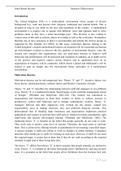John Obison Stevens Business Effectiveness
Introduction
The United Kingdom (UK) is a multicultural environment where people of diverse
background live, work and practice their religious, traditional and cultural beliefs. This is
accepted as long as you abide by the laws and legislation of the country. A multicultural
environment is a positive one as people with different views and opinions tend to solve
problems easier as they have a richer knowledge pool. This diversity is also evident in
various areas of life such as schools, places of worship as well as the work place. Workplaces
therefore has to have structures in place to accommodate and tolerate the diverse groups as
supported by The Equality Act (2010). In this essay, motivation theories relating to the
United Kingdom’s modern multicultural business environment will be researched and backed
up with literature evidence to discover the key qualities of motivational theories. Also, the
reasons why mangers and organisations may use motivation theories to improve staff
behaviour and performances will be discussed and examined. In addition, an in depth review
of the positive and negative impact various theories and its application have on an
organisation or business will be conducted. ASDA Stores Limited and McDonald’s will be
studied to gain an insight into the motivational theory principles in a multicultural
environment.
Motivation theories.
Motivation theories can be sub-categorised into: Theory ‘X’ and ‘Y’, incentive theory, two
factor theory, satisfaction theory, intrinsic theory and Maslow’s hierarchy of needs.
Theory ‘X’ and ‘Y’ describes the relationships between staff and managers in two different
ways. Theory ‘X’ is a traditional formula ‘based largely on the scientific management school
of thought’. (Whiddett and Hollyforde, 2002:142). This method was introduced to
organisations and businesses to keep their workers in check, to enforce increase in
productivity, control staff behaviour and to manage contemporary workers. Theory ‘X’
managers believed that their employees only worked for the money, wanted less
responsibility, poor in making decisions, lazy and preferred financial rewards. This
philosophical idea of thinking made businesses and organisations implement practical
applications and systems to motivate their staff such as: financial rewards, punishments, tight
supervision and specific job-assigned training. (Whiddett and Hollyforde, 2002). The
traditional theory ‘X’ is founded on the belief that people generally do not want to work.
They work only to achieve some level of security. Therefore, the need arises to motivate
them. This is achieved by offering rewards or punishment for not meeting a specified target.
A typical example is staffs not willing to work on Sundays or public holidays. Companies
therefore offer double pay to staffs for working on such days. However, if staffs do not meet
the required target, it creates fear in them that if they do not work according to the required
standard it might lead to them losing their jobs.
The theory ’Y’ differs from theory ‘X’ in that it assumes that people naturally are inclined to
work. Theory ‘Y’ is founded on the belief that people derive fulfilment by carrying out their
tasks. It is grounded on the belief that people derive fulfilment from the freedom their jobs
1|Page
, John Obison Stevens Business Effectiveness
offers. This theory was proposed by Douglas McGregor. We know that this is not always true
as people are much more inclined to work when there are financial incentives at play.
The incentive theory is based on offering workers incentives. Incentives are those things that
will encourage workers to work. This strategy enables employees to receive rewards and
bonuses in the form of money, gift cards or gifts as a token of appreciation for reaching a
goals or for working hard. However, Edmonds says that: ‘If employees reward their staff
financially, it will only last for a short period’ (Edmonds, 2013, cited in Silvera, 2013). The
statement made by Edmonds suggests that employees might not be satisfied and motivated by
financial advancements and perhaps this statement may imply that business and organisations
are looking for some long term motivators rather than short term.
Intrinsic theory is the belief that the reward will occur after a task or goal is accomplished.
Such as: promotion, recognition and personal satisfaction. Intrinsic motivated workers are
unlikely to be interested in financially rewards unlike incentive motivated employees.
However, research has shown that if an intrinsic motivated employee is constantly rewarded
with incentive rewards a decrease in motivation and job interest is likely to occur (Whiddett
and Hollyforde, 2002).
Abraham Maslow is an American physiologist who created the hierarchy of needs theory.
The Maslow’s hierarchy of needs consists of the level of importance each need is. The
hierarchy consists of: safety needs self-actualisation needs, physiological needs, esteem and
belongingness needs. Research indicates that Maslow’s hierarchy of needs theory is a vital
motivation application that should be applied to any organisation to build a healthy and
strong relationship with the employees (Maslow, 1943).
The Hierarchy of needs model
(McLeod, 2016).
2|Page




